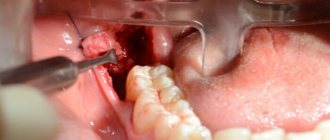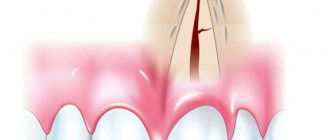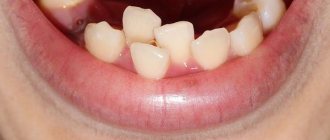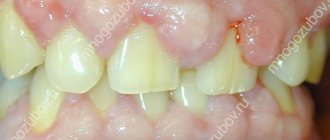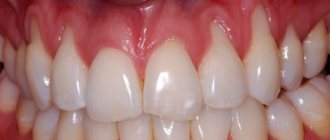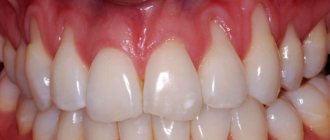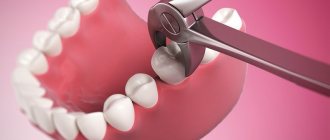Content:
- A competent approach to the problem
- If the very first teeth are crooked
- Causes of crooked teeth
- What to do if a tooth grows crookedly
- Do I need to straighten crooked teeth?
Seeing that a canine or incisor is “looking in the wrong direction,” parents immediately ask the question whether baby teeth can grow crooked. Knowing the correct answer to this is very important, because failure to take therapeutic measures in a timely manner can result in an unaesthetic smile in adulthood.
Teeth changing mechanism
A child’s nature dictates a sequence of teething. They appear one after another in exact sequence. The central incisors are shown first, and then the lateral incisors, etc. They also fall out at a certain time. The replacement of baby teeth occurs at the age of 6 - 7 years, but there are also deviations. Undesirable factors can interfere with teething. It also happens that all deadlines are violated, in this case it is advisable to go to the dentist. If teething starts too early or late, then there is nothing wrong with it, don’t worry - it won’t affect the baby’s health.
A competent approach to the problem
Dentists recommend bringing children for routine examinations to the dental clinic starting from the age of two. Already at this age, the doctor can discern the features of the developing bite and tell whether additional corrective measures will be required. If some teeth erupt very crookedly, he will tell you how they can be straightened so that in the future they will stand correctly.
Some mothers and fathers consider such careful attention to a child’s crooked baby teeth to be unnecessary. They explain their position by the fact that temporary teeth will soon fall out, and it is possible that they will be replaced by straight permanent ones.
Of course, you can hope for chance. As practice shows, a crooked baby tooth is often replaced by an equally permanent one. The doctor will conduct a diagnosis and determine whether the growth of the unit needs to be adjusted. Parents can rest assured that modern methods of preventing serious orthodontic problems do not cause pain or discomfort. Therefore, they can be safely used even when working with three-year-old children.
Reasons for the development of edentia
Primary dental edentia is a genetic disorder, the origins of which have not been fully studied. The frequency of pathology in different years is recorded in 1-2% of the population.
Complete and partial secondary adentia are diseases that dentists constantly encounter. Doctors name several reasons for the loss
dental units:
- Advanced caries, pulpitis. An indirect cause that triggers the destruction of tooth tissue. After removal of the neurovascular bundle, the tooth becomes fragile and requires careful attention. If the patient comes late, the doctor resorts to removing the unit.
- Diseases of periodontal tissues. The ligament cannot hold the tooth in the socket, and the crown begins to loosen. In the absence of proper treatment, the process spreads to the gums and destroys the structure of the jaw bone.
- Injuries. Dislocations, fractures, bruises, cracks of teeth and roots resulting from mechanical stress often lead to partial or complete loss of a row.
Less commonly, adentia becomes a consequence of previous somatic ailments - endocrine, oncological or others, accompanied by changes in tissue structure and weakening of the immune system.
If the very first teeth are crooked
The first lower incisors erupt between the ages of six months and one year. They often grow in an "L" shape. This is the norm. This situation definitely does not require any treatment. By the time of complete eruption, the units are aligned and become correct.
If parents are very worried, they can speed up the process of stabilizing the position of the incisors. To do this, the baby should be given to drink from a bottle with a special tight nipple with a small hole. When using it, the baby will make more effort when sucking.
Another situation that should not worry is the even spacing between the first teeth. They disappear when the chewing units erupt. Dentists recommend paying attention only to uneven and too wide diastemas. They most often have to be closed with plates and braces.
Tips for parents on prevention
1. Wean your child off pacifiers in a timely manner (from about 8 to 9 months, since it is during this period that the baby develops a chewing reflex and the need for sucking decreases) or replace them with anatomically shaped vestibular plates.
2. Fight your child’s bad habits. Wean him off, for example, thumb sucking or nail biting.
3. Monitor your child’s diet, including more solid fresh vegetables and fruits in his diet - carrots, apples, pears, cucumbers and the like.
4. Monitor the health of teeth (including milk teeth) and gums by forcing your child to maintain oral hygiene. Visit the dentist with your child at least twice a year: treat caries and other dental diseases and try to prevent the loss of baby teeth too early - this can lead to displacement of the entire dentition. If premature removal of a baby tooth is unavoidable, doctors advise replacing it with a removable denture.
Causes of crooked teeth
There are quite a few factors that determine the curvature of milk units. Sometimes parents are to blame for the violation, because they do not allow their grown-up child to chew solid food on their own for too long or ignore the symptoms of calcium deficiency. It also happens that the curvature is caused by the individual characteristics of the baby’s body. This is what the most common causes of curvature look like:
- hereditary predisposition;
- chronic pathologies of the nasopharynx, forcing the baby to constantly breathe through the mouth;
- speech therapy disorders not corrected in a timely manner;
- too short frenulum, anatomically large tongue;
- bad habit of sucking fingers, gnawing foreign objects;
- Bottle feeding your baby once he or she reaches one year of age.
All these are factors that contribute to the curvature of baby teeth. If the violation is obvious, there is no need to panic. The doctor will select a method that will quickly straighten the teeth. Moreover, the sooner treatment is started, the better. Therefore, there is no need to delay seeking dental care.
Why is the position of teeth in a row disturbed?
Why do teeth grow unevenly? There are several reasons, the main ones are listed below.
- Hereditary predisposition. If parents or other close relatives first developed dental problems in childhood, the risk of acquiring an uneven row of teeth increases significantly.
- Deficiency of calcium, phosphorus and other nutrients in the body. The cause may be both nutritional deficiency and digestive tract disorders.
- Pathology that arose in the antenatal period. Due to excess or lack of amniotic fluid, entanglement with the umbilical cord, and the influence of teratogenic drugs, birth defects appear.
- Diseases of the upper respiratory tract, leading to changes in the function of external respiration.
Factors such as irrational and unhealthy diet, pathology of jaw and dental growth also influence. All this leads to the child’s teeth growing unevenly.
What to do if a tooth grows crookedly
If parents see that a tooth is very crooked, there are uneven gaps between the units, they need to take the child to an appointment at the dental clinic. It is possible that their experiences are far-fetched. Then the doctor will calm you down and tell you how to properly care for your teeth so that the imaginary problem does not become a reality.
If there really is a curvature, removable orthodontic trainers will help remove it at the age of under seven years. They are a flexible silicone mouthguard. It forces the units to take the correct position. Most often it is enough to wear it only at night. But sometimes short wearing during the day is required.
Between the ages of seven and twelve years, the bite is corrected using removable plastic plates. They are made from individual casts. You can remove the mouthguard only when brushing your teeth and eating. The period of getting used to it takes from one to two weeks.
Braces are recommended for patients over 12 years of age. They are used for crooked permanent teeth. Breast units are never leveled using braces.
Devices for correcting uneven teeth
There are several reliable and effective treatment methods. They differ from each other in some respects. To choose the best option, you should talk to a pediatric dentist who treats children’s teeth. Trainers and removable plates.
They can be used from an early age. Recommended age is 4-6 years. In this case, it is necessary to wear trainers every day; they are often worn at night. The significant difference is that the device is removable.
Aligner trays.
They begin to wear them at the age of 16.
You need to wear them constantly and take them off only when eating. Braces.
They are given mainly to persons over 18 years of age. They need to be worn for a long time, on average about two years.
Do I need to straighten crooked teeth?
It is wrong to treat dental curvatures only from the standpoint of a violation of aesthetics. There is no need to think that the existing defect spoils the smile slightly, and therefore it is not necessary to correct it.
Incorrectly positioned teeth can also lead to more serious problems, such as poor hygiene. Then plaque will constantly accumulate in the interdental spaces. Pathogenic microorganisms will begin to actively multiply in it, which means caries will not be long in coming. If treatment is not carried out at this stage, the destructive process will spread to the deep tissues of the tooth and bone. Then removal will be required. If the milk unit is pulled out much earlier than the time when it should have fallen out on its own, its neighbors will take its place. And this is a serious malocclusion.
Another complication that crooked baby teeth lead to is uneven load on the jaw. It is fraught with abrasion of healthy teeth and disturbances in the functioning of the temporomandibular apparatus. It also negatively affects the functioning of the digestive and respiratory systems.
This is how many problems can arise due to a simple reluctance to straighten a crooked tooth. Therefore, do not delay your visit to the doctor. Take care of the health of your child's smile from early childhood.
Problems that accompany the loss of chewing teeth
The absence of teeth primarily affects the inability to eat properly. If teeth are removed only on one side, then an increased load falls on the other, which means that the jaw joint is overloaded in a certain area, a crunch appears when the jaw moves, headaches develop, and over time, facial asymmetry may occur. If teeth are missing on only one jaw, then those located on the opposite jaw begin to shift, i.e. fall out of the sockets because they do not receive full support from the antagonist teeth. Naturally, bone tissue atrophy occurs in the area of missing teeth, which remains without the natural chewing load.
The absence of chewing teeth also entails aesthetic disturbances. Even if the defect is not noticeable when smiling, the cheeks become sunken and a large number of wrinkles form. Problems of the digestive tract also arise, especially if chewing teeth are missing on both sides at once - this is the result of inadequate and poor-quality chewing of food and a transition to softer foods.
Removal of abnormally growing eighth tooth
Very often, if the third molar grows abnormally, it is necessary to resort to its removal. Indications for surgery:
- Repeated cases of pericoronitis (purulent formation in the gum pocket). This problem most often occurs on the lower eights, which have not completely erupted. Pericoronitis is usually treated by removing the overhanging gum, but if the disease recurs, it is recommended to remove the offending tooth.
- The upper eight grows into the cheek, constantly injuring it. To avoid the formation of ulcers and infection of the oral cavity, as well as to prevent pain, wisdom tooth removal is required.
- The development of wisdom tooth dystopia was diagnosed. The tooth grows at an incorrect angle, which can lead to inflammation of the periodontal tissues and the development of caries on the eighth and neighboring teeth.
- The wisdom tooth grows to the side and affects the ternary nerve, causing attacks of pain. Most often, this occurs when an unerupted figure eight rests on the roots of neighboring teeth. Such an anomaly can only be diagnosed using an x-ray.
The procedure for performing the manipulation may differ depending on the location of the tooth. The sequence of the procedure during surgery:
- antiseptic treatment of the operating area;
- administration of anesthetic;
- tooth extraction;
- inserting a gauze swab into the hole to eliminate bleeding.
The tampon should be removed from the wound no earlier than after 25 minutes. The tampon must be in the socket to prevent bleeding. After the operation, the dental surgeon gives recommendations that must be strictly followed.
Is leveling expensive?
When a child’s new baby (permanent) teeth are cutting and growing crookedly and a decision is made about therapy, you need to be prepared to pay a “round” sum. The final cost of corrective measures depends on the complexity of the diagnosis and the chosen treatment option. One of the most affordable designs is a removable plate. The price ranges from 5 to 7 thousand rubles. A non-removable accessory will cost twice as much.
Trainers are also available, but will cost from 8 thousand rubles. (this includes the product itself, consultation, selection and regular monitoring of the patient). Braces are the most expensive. A full cycle with all related services can cost between 80-100 thousand rubles. This is not only the installation and constant correction of the system, but also the initial examination, diagnosis, taking impressions, sanitation of the oral cavity, dismantling and subsequent restorative procedures. To clarify the cost, we recommend that you contact the clinic in person, since the amount directly depends on the individual characteristics of the patient, drug tolerance, the need for preliminary treatment and other nuances.
